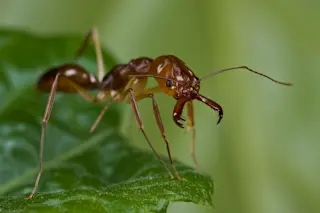A trap-jaw ant. (Credit: kurt_G/Shutterstock) To settle a labor dispute, ants put up their dukes. And when the bell rings, they can unleash a flurry of punches in the blink of an eye. A new study from researchers at the University of Illinois and North Carolina State University used slow-motion videos to watch trap-jaw worker ants square off in antenna boxing matches. Trap-jaw ants communicate via pheromones, but when it's time to divvy up tasks peaceful negotiation is off the table. These fast-paced antenna slap-ups, called rapid antennation, determine which ant must perform less desirable chores for the good of the colony. Researchers knew about these dust-ups, but no one had measured how fast rapid antennation really is.
Led by undergraduate researcher Sean O'Fallon of the University of Illinois, the research team observed four species of trap-jaw ants to measure how quickly they traded blows. The slowest, and largest, of ...














